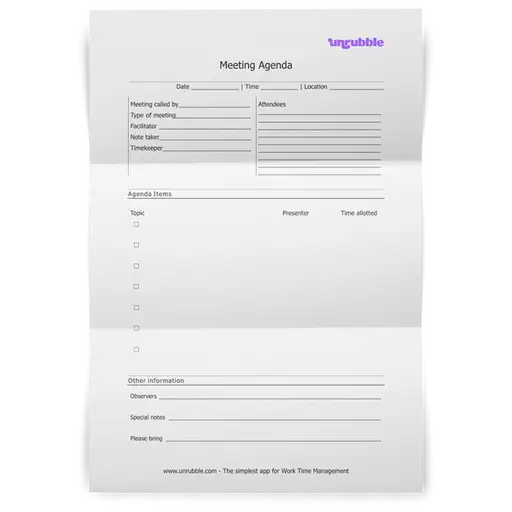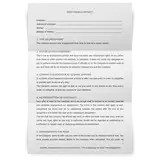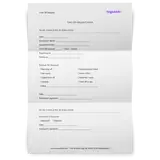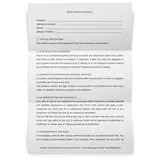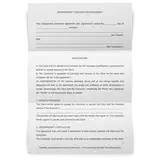When you’re planning to lead a meeting, a meeting agenda template is the best thing to have if you want to easily manage tasks and keep participants fully informed and on the same page as you. The good thing is our simple meeting agenda template is available for this exact purpose. In this article, we cover all you need to know about this effective and customizable tool.
Here’s a sample Meeting Agenda template that can be easily customized and adapted to meet your requirements. It’s free to download and use.
What’s a meeting agenda template?
A meeting agenda template is what you need when you want to avoid the time-consuming process of creating a meeting agenda. This means all you have to do is whip out a meeting agenda anytime you need to lead a meeting. Generally, a meeting agenda has several crucial functions.
It helps you to easily communicate the main agenda or points of a meeting. It contains important elements that keep employees, colleagues, clients, and prospects in the loop when it comes to who will be there and what will be talked about. Whether you’re looking for a daily agenda template or weekly agenda template, you’ll find it easy to customize our template, so that it meets your needs.
Additionally, you can customize our template to create the following types of templates:
- Staff meeting agenda template – Staff meetings are typically casual settings and this template works for a variety of staff meetings, from marketing to sales.
- Board meeting agenda template – This is a more formal type of meeting, so the information you add to the template needs to be a bit more detailed.
- Team meeting agenda template – Our template will help you organize an internal team meeting for the purposes of reviewing your team’s performance.
Before we look at how our simple tool works, it’s best to understand why this document is even important enough to warrant discussion.
To start off, you’re probably familiar with how the word “meeting” is closely associated with boredom. Most meetings are a waste of time for all participants, and thousands of hours of work are regularly lost due to unproductive and inefficient meetings.
That’s not to say that meetings should be banished because they are a necessary part of effective communication both in the workplace and outside of it. To ensure meetings remain on point, you’ll need good planning skills to create an effective meeting agenda. Since you already have access to one, you can happily skip this step and immediately start enjoying the benefits of a well-crafted meeting agenda.
The main elements of a meeting agenda
In a nutshell, a carefully planned and simple meeting agenda has the following basic building blocks:
- Topic of the main agenda
- Name of the person who called the meeting
- Name of the facilitator
- Date
- Time
- Location
- List of attendees
- Name of the note keeper
- Name of the timekeeper
- A breakdown of agenda items, including the name of the presenter and their allotted time
- What participants should bring
- Any other information or special notes
Overall, having this information in one place ensures that organizers and attendees can both prepare for the meeting ahead of time. Let’s look at how each key element contributes to an effective meeting agenda.
The main agenda
This is the main purpose of the meeting, and you'll find it at the top of the page. It answers the question, “Why are we having this meeting?” For instance, if you have a nonprofit board meeting agenda template, the main agenda topic can be, Quarterly Budget Meeting Agenda.
This section serves two purposes. It announces that a meeting is, in fact, taking place and it gives a clear idea of why the meeting is happening, as well as present a list of topics so that you keep the meeting on track.
If you don't have retrospective meetings to base the agenda on, our template will help you create a good agenda and avoid unproductive meetings.
The attendees
Our meeting agenda template also allows you to input information about who will be there and the roles they have been assigned. Each participant will therefore step into the meeting knowing what they’re supposed to do.
The meeting participants will also have enough time to prepare for it, so the meeting is bound to proceed smoothly. Our team meeting agenda template has different sections where you can list the names of attendees or observers.
You can then assign roles such as presenters, timekeepers, and note keepers. Having someone who’s responsible for jotting down the minutes ensures that there will always be accurate records to refer back to when a particular discussion comes up.
Whether it's project kickoff meetings, or one-on-one meetings, this template will keep the entire team aligned.
Date, location, and time
Your meeting agenda needs to have a time, date, and location. Attendees need to be able to schedule the meeting on their calendar, so it doesn’t clash with other work activities. Since meetings frequently occur online nowadays, knowing the location also helps attendees know if they have to leave the office or stay at their desk during the meeting.
Agenda items
Having a breakdown of the meeting program enables attendees to know what’s going to be discussed at the meeting and the time needed to cover each agenda item.
As an organizer, it also helps you manage time effectively, so participants don’t end up zoning out because the meeting has dragged on for too long and they lost track of discussion topics and the key decisions made at the meeting.
Each presenter will know how much time they have, and there will be a timekeeper to remind everyone to stick to their allotted time frame and have more productive meetings. You can set the agenda items based on previous meetings.
Other information
When it comes to creating an effective meeting agenda, it’s not always easy to compartmentalize every piece of information. That’s why our meeting agenda template includes a section for any other information. Here you can put down any special meeting notes that are relevant to that particular meeting, e.g. status updates or key metrics to be followed.
You can even put down special requests. For instance, you can ask participants to bring a notebook and pen or ask them to carry out some research that’s crucial to the meeting's progress. Or you can use certain software to take notes in real times, so that everyone is informed about the meting topic and synced at once.
The benefits of our meeting agenda template
Now that you have a great and comprehensive meeting agenda all filled out, what next? Keep in mind that meeting agendas only work effectively when they are sent out well in advance.
This gives attendees ample opportunity to gather any information or items they might need during the meeting. It allows participants to figure out any issues or questions they may need to raise to fully realize the goals of the meeting.
Our meeting agenda can be quickly sent via email or printed out and distributed to attendees, which is quite handy. There are more benefits to enjoy when you use our simple meeting agenda template correctly:
Helps with preparation and planning
Since you don’t have to spend time designing a meeting agenda, you’ll have more time to prepare for your meeting. This ensures you’re not overwhelmed since you can send out the agenda ahead of time and collect any feedback that allows you to further refine the meeting agenda.
Whether you run formal meetings, hybrid meetings or other types of meetings, these templates help you optimize meeting time, track action items and and get creative juices flowing ahead of time.
Helps you set out objectives and goals
As the meeting leader and organizer, it’s also essential that you have a clear reason for setting the meeting in the first place.
Having a template to work with helps you narrow down your objectives and note down the end goal for your meeting. This way, you’ll be able to steer the meeting in the right direction when the time comes and you'll have all the discussion items neatly laid out in front of you.
Improves productivity
When you have the meeting goals and objectives on hand, it’s now easier to stay on track even when you have to organize follow-up meetings. This avoids the issue of focusing on the same old issue over and over again, which usually happens with poorly planned meetings that go over the dedicated time slot.
As mentioned earlier, an effective meeting agenda can save your organization plenty of time. Additionally, there’s no better feeling than being able to resolve issues and wrap up the meeting with a sense of accomplishment and the feeling of a job well done for your overarching goals.
Fosters better communication
Using an effective and simple meeting agenda template also helps with communication between you and the attendees. It allows you to inform participants about any issues that need to be addressed to keep the organization running smoothly. A team meeting agenda template keeps members from all departments on the same page so they can work towards a common goal.
If you have regular meetings, a basic meeting agenda template will help you have shorter meetings, get constructive feedback from your team, prepare a list of action items to complete, as well as foster active participation from your team.
Even for meetings with regular intervals, such as daily standup meetings that require active participation, a simple agenda can keep the project team aligned on crucial topics. Time allocation does not come naturally, it's a learned skill that becomes easier with a formal agenda for ongoing projects.
The bottom line
Our simple meeting agenda template is suited for all sorts of organizations and teams, and you can easily customize it to meet changing needs and agendas and keep a productive discussion going.
Overall, you can use it to foster organizational change that redefines the negative culture surrounding meetings. You'll have an easier time crushing meeting objectives, staying on the meeting topic and getting a fair share of experience in tracking goal progress.
Whether you’re an HR leader or business owner, this document should be part of your handy arsenal of tools for implementing best practices that help you manage people and tasks efficiently and responsibly.
